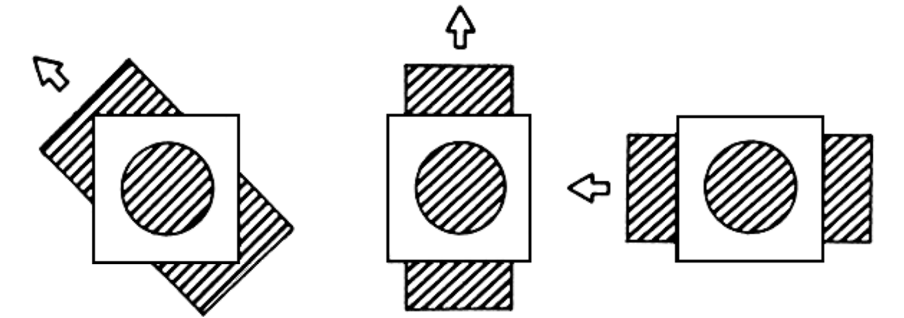The Woman Who Couldn’t See Motion: How LM Advanced Our Understanding of Motion Perception
Estimated reading time: 8 minutes
Imagine crossing a street as cars appear to teleport from one place to another or trying to pour a cup of tea only to see the liquid freeze and then overflow. Visual motion is such a fundamental part of our vision that we cannot imagine a world without it. For a woman known as LM, the world appeared as a series of still images. Her story would help us understand how we see motion.
A world without motion
In 1983, Zihl, von Cramon and Mai published a remarkable case study that shaped our understanding of motion vision. The patient, referred to as LM, was 43 years old and had suffered a brain haemorrhage that affected both sides of her brain, in a region near the back, known as the lateral temporo-occipital lobe. The injury was outside the primary visual cortex considered the only visual area at the time. Despite having sharp, clear vision, she was unable to perceive motion. She was initially misdiagnosed with a “bizarre visual disorder mimicking agoraphobia,” but her condition was far more complex.
“People, dogs and cars appear restless, are suddenly here and then there, but disappear in between. Very often I don’t even know where they have left because they move too fast”(Zihl et al., 1983).
LM could not see fluid movement. To her, the moving world appeared as a collection of frozen images, and simple daily tasks, such as pouring tea or crossing the street, were extremely difficult. Her reluctance to social spaces was not rooted in a phobia, but a disconnect. To her, people would suddenly appear in a room and then disappear before her eyes. Talking to people was particularly unnerving as they would appear to speak without moving their lips.
"When I'm looking at the car first, it seems far away. But then, when I want to cross the road, suddenly the car is very near.”
The case of LM advanced our understanding of the brain
LM was not the first reported case of motion blindness, but hers was the first case in which the symptoms and brain damage were so precisely linked. Reports dating back to 1911 described patients with motion blindness. However, those patients had additional impairments, such as anomic aphasia (an inability to name objects despite recognising them) and sometimes, also concentric vision loss. See Potzl and Redlich (1911) and Goldstein and Gelb (1918) for details.
What made LM’s case particularly significant was the combination of the selectivity and specificity of her condition (Zihl & Heywood, 2015). Selectivity refers to the clearly defined impairment that exclusively affected her motion vision and spared all other visual functions, such as form, colour, depth, object and face recognition. Specificity means that her motion blindness could not be explained by any deficits, making it a clear consequence of her bilateral injury to the visual brain. This suggested that motion is a distinct visual function, relying on mechanisms beyond the primary visual cortex.
“The selectivity of the visual disturbance supports the idea that movement vision is a separate visual function depending on neuronal mechanisms beyond the primary visual cortex” (Zihl & Heywood, 2015).
Defining the MT/V5 area
CT scans revealed damage in LM’s lateral temporo-occipital cortex, corresponding to the middle temporal area (MT). Given both the location and the nature of her visual loss, Zihl and colleagues (1983) proposed that this region was the human equivalent of area V5 in rhesus monkeys, where Semir Zeki (1974) had found a dense concentration of direction-sensitive neurons which responded selectively to motion in a specific direction.
Just a quick note on the terminology: you will often see the names MT, V5 and MT/V5 used interchangeably. V5 comes from functional mapping studies and is commonly used when discussing visual function. MT (Middle Temporal area) refers to its anatomical location. While we are on this topic, V1, the primary visual cortex, also has several names: striate cortex, area 17 or Brodmann area 17.
In 1969, Hubel and Wiesel identified direction-selective cells in V1. At the time of LM, the dominant view was that motion processing happened primarily in this area. Zeki’s later discovery of direction-sensitive neurons in V5 suggested that motion signals from V1 could be further processed there, but the idea that V5 played a central role in motion perception was still speculative.
Then came the case of LM. Her motion blindness, caused by damage to the human equivalent of V5, provided compelling evidence that V5 was essential for the experience of visual motion.
“Neurons in V5 solve the aperture problem by
integrating local motion signals into a global perception.”
How V5 Builds motion
The retina in the eye is a mosaic of tiny receptive fields. Think of a receptive field as the area that a neuron can "see." As visual information travels through the brain, neurons combine inputs from earlier stages, creating progressively larger receptive fields capable of detecting more complex features.
Neurons in V1 have smaller receptive fields than V5 and can only detect local motion. This is known as the aperture problem, illustrated below. As seen from V1, the movement is ambiguous and does not reveal the actual global direction of movement.

Area V5 is particularly tuned for motion. Neurons here are sensitive to speed and direction of movement across all axes. Neurons in V5, with a larger receptive field, solve the aperture problem by integrating input across multiple V1 neurons, allowing the brain to reconstruct the global motion of the entire object, rather than the local motion of its parts.
If you would like to know precisely how the neurons at any stage reconstruct visual information, ask away.
V5 does not just add motion signals, it integrates them
V5 does not simply summate movement input but rather integrates it into a unified coherent perception. This has been demonstrated in macaque monkeys, where researchers recorded neuronal responses to different motion stimuli (see image below). In this experiment, two moving gratings, drifting in different orthogonal directions, were combined to form a plaid pattern. This created the illusion of movement in a new, diagonal direction (see orange arrow). The monkeys were shown all three types of motion stimuli.
As mentioned earlier, the direction-selective neurons in V1 respond maximally to motion in a specific direction, with different neurons responding to different preferred directions.
When the stimuli were shown to the monkeys, V1 neurons responded strongly to the individual gratings, according to their preferred direction (horizontal or vertical). They also responded during the plaid stimulus, since it is made of two overlapping gratings. However, a section of neurons in V5 responded only to the overall motion of the plaid and not to the individual gratings. This suggests that V5 is not just summing inputs but actively computing a new, global direction of motion. In doing so, V5 creates a higher-level representation of movement.

“Without motion, the world becomes fragmented. Communication loses its rhythm.”
V5 in daily life
The profound impact of V5 damage on LM's quality of life highlights the importance of this area. It contributes to several aspects of visual processing, including but not limited to:
Depth perception through motion parallax. Video gamers will recognise this. It involves extracting depth cues from the relative movement of objects as we move through the environment. Objects closer to us appear to move faster than those further away.
Biological motion. This refers to recognising movement patterns in living beings, such as recognising a friend by their walk. Biological motion is also key for interpreting social cues, such as body language.
Eye tracking and coordination. This includes tracking a moving object or seeing people walk in and out of rooms and generally interacting in the world. It is also necessary for writing, which was slower for LM as she could not track fast hand movements.
Interpreting dynamic social cues This includes facial expressions and gestures, which are crucial for understanding the actions and intentions of others.
Without these functions, the world becomes fragmented. Reading intentions and emotions in others becomes difficult, face-to-face conversations feel disorienting and communication overall loses its natural rhythm.
How LM managed
Despite her life-changing condition, LM faced her challenges head-on. She was resilient and showed no symptoms of depression or anxiety. She learnt to manage her condition by avoiding crowded places and situations with multiple moving stimuli. She adopted clever strategies, such as avoiding looking directly at moving objects and focusing her gaze on stationary features in her environment. She relied on other senses, like focusing on hearing to estimate the distance of cars, and overall tried to keep her autonomy as much as possible (Zihl & Heywood, 2015).
LM's contribution
LM's generosity to science was invaluable. She volunteered for countless, exhausting tests for over two decades, knowing that they would only help others. All aspects of her perception and psychological state were tested repeatedly, particularly as methods improved over the years. Her patience, strength and collaboration allowed researchers to understand motion in ways that go beyond what I can cover here. MT/V5 is currently the most studied visual area and is now known to be involved in integrating motion input from other senses (audio, touch) and to have links to attention and emotion.
“It is easy to assume that as long as we can see clearly,
not seeing motion would not be so bad.”
Conclusion: Why her story matters
The story of LM is my favourite case study in neuroscience because it so clearly illustrates the complexity and fragility of human perception. It reveals how deeply we rely on our senses, not just to navigate the world but to connect with others and find belonging and meaning in everyday life. It also fosters compassion and awe of how wonderful it is to see.
It is easy to assume that as long as our vision is sharp, losing the ability to see motion could be manageable. But LM’s experience reveals how disorienting, isolating, and even frightening it can be when just one part of our perception goes missing.
Her case is a direct example of how every aspect of perception shapes our emotional and social life and is a reminder that science is built on the struggles and generosity of others. Next time you pour yourself a cup of tea, think of LM and how wonderful it is to see motion at all.
What is another aspect of your own perception that you take for granted? How would your life change without it?
If LM’s story moved you, subscribe for more stories and insights into how the brain constructs our experience of reality and connection with others.
References
Gelb, A., & Goldstein, K. (1918). Psychologische Analysen hirnpathologischer Fälle auf Grund von Untersuchungen Hirnverletzter. I. Zeitschrift für die gesamte Neurologie und Psychiatrie, 41, 1-142.
Hubel, D. H., & Wiesel, T. N. (1969). Visual area of the lateral suprasylvian gyrus (Clare-Bishop area) of the cat. The Journal of Physiology, 202(1), 251-260.
Movshon, J. A., Adelson, E. H., Gizzi, M. S., & Newsome, W. T. (1986). The analysis of moving visual patterns. In C. Chagas, R. Gattass, & C. Gross (Eds.), Pattern recognition mechanisms (pp. 117–151). Vatican City: Pontificia Academia Scientiarum.
Potzl, O., & Redlich, E. (1911). Demonstration eines Falles von bilateraler Affektion beider Occipitallapen. Weiner Klinsche Wochenschrift, 24, 517-18.
Zeki, S. M. (1974). Functional organization of a visual area in the posterior bank of the superior temporal sulcus of the rhesus monkey. The Journal of physiology, 236(3), 549-573.
Zihl, J., & Heywood, C. A. (2015). The contribution of LM to the neuroscience of movement vision. Frontiers in Integrative Neuroscience, 9, 6.
Zihl, J., von Cramon, D., & Mai, N. (1983). Selective disturbance of movement vision after bilateral brain damage. Brain, 106(2), 313-340.



i’m from linkedin and omg i can’t wait to get my teeth into your posts later!! i’m job hunting today but will read when i’m done!!!!
Amazing…thanks for sharing!